Various types of cookies are used on our website (and on all other digital platforms including mobile applications). View our new THE INFORMATIVE TEXT ON LPPD AND PRIVACY here. Google Analytics Analytical cookies help us to improve our website by collecting and reporting information on its usage. Google AdWords ve Remarketing We use marketing cookies to help us improve the relevancy of advertising campaigns you receive.
I have read the above articles

CKL Series Serial to Ethernet Gateway is one device with 6 different functions.
Serial to Ethernet Transparent Gateway Function: It can work in TCP Server mode so that TCP client devices can connect to CKL and CKL will act as transparent gateway between TCP devices and field serial devices.
It can work in TCP client mode and CKL can automatically connect remote TCP devices and act as transparent gateway between field serial devices and remote TCP devices.
Modbus TCP/RTU Protocol Gateway Function: Modbus TCP master devices can connect to CKL and CKL will act as converter between Modbus TCP master devices and field Modbus RTU serial devices.
Also Modbus RTU master devices can connect to CKL and CKL will act as converter between Modbus RTU master devices and field Modbus TCP devices by connecting them via Modbus Address to Target TCP IP List.
Modbus TCP/RTU Scheduler with MQTT Data Send Function: CKL can read field Modbus TCP or Modbus RTU devices based on predefined Modbus list and send read Modbus data to MQTT server based on predefined period. Up to 64 Modbus commands can be defined. This functions are not available in LITE Models.
Typical applications: Automated Meter reading, Home – Building – Industrial Automation, Remote Control, Remote I/O, Telemetry…
CKL series with Broadband Power Line (BPL) link allows device to communicate with full transparent TCP/IP standard over Low Voltage power lines and allows easy connection between TCP/IP based terminals without use of extra cables.
CKL Lite Models are cost effective solutions for Transparent and Modbus, Serial to Ethernet conversion communication needs. CKL - Lite model has hardware and functional differences than normal models.
CKL Series Modbus, Serial to Ethernet Gateways have the versions with and without BPL (Broadband Power Line ) Link.
Each device has a Din-Rail kit on rear panel. The Din-Rail kit helps device to fix on the Din-Rail. Slant the switch and mount the metal spring to Din-Rail.
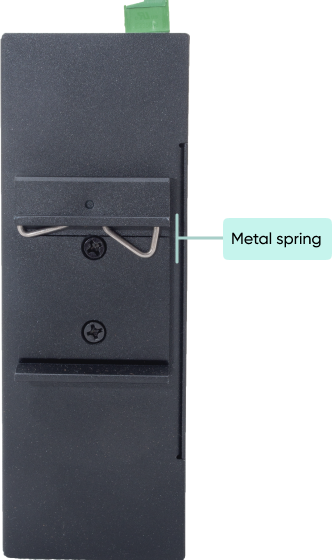
Then Push the switch toward the Din-Rail until you heard a “click” sound.

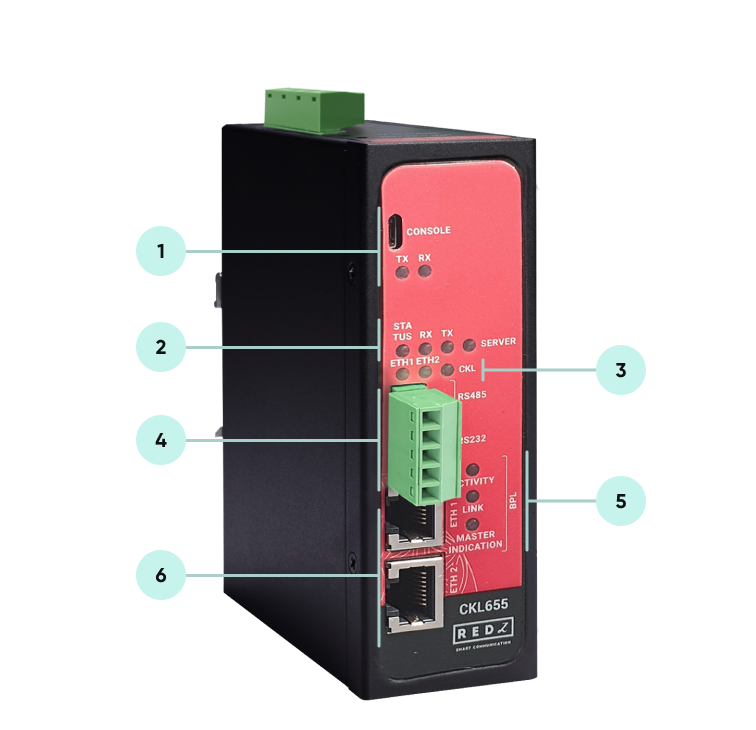
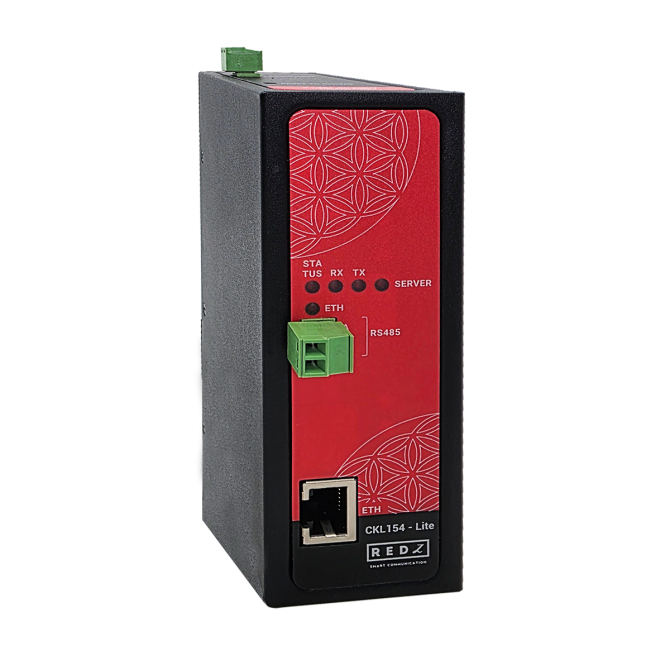
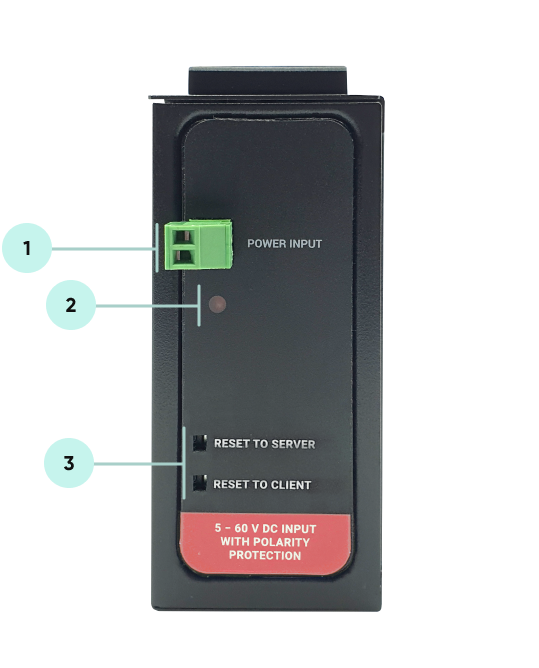
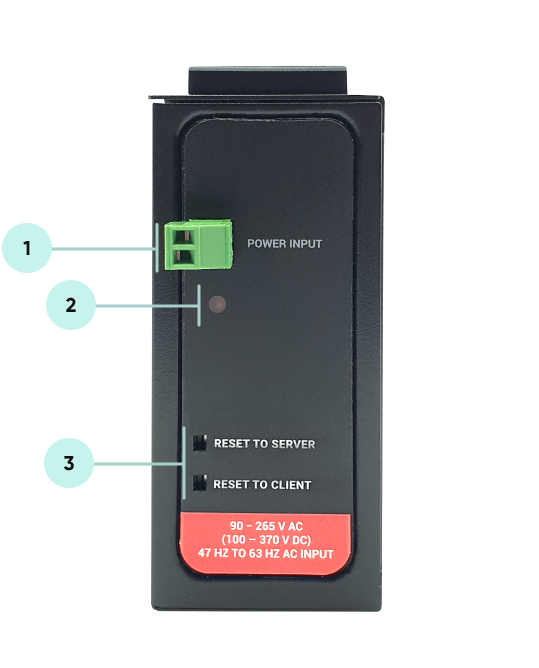

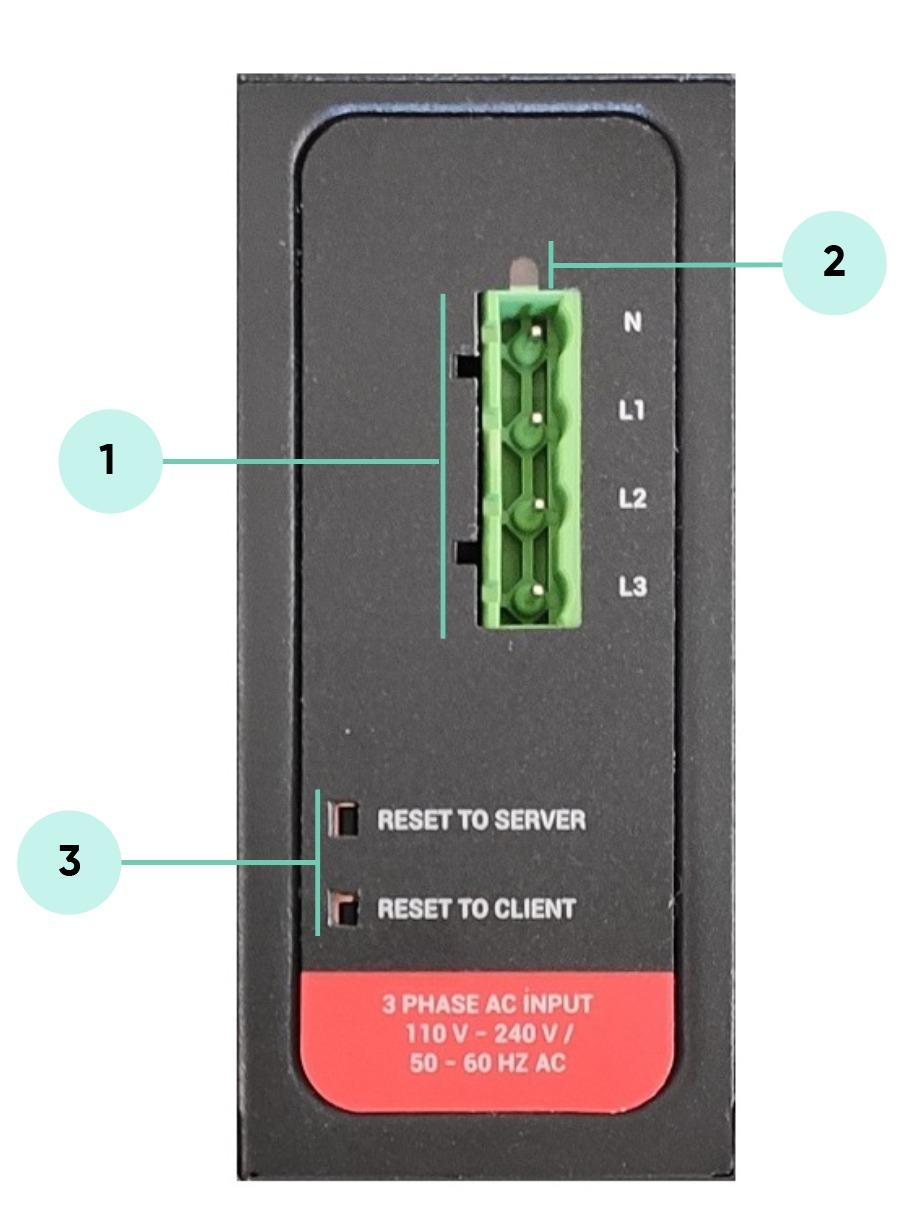

NOTE1 : BPL Model can be purchased in 2 versions:
1. P-N Model: Phase to neutral model (Standart Model). That version gets power from terminal pins 1 and 2 from phase and neutral. It can also transmit data from that pins and other pins usage is optional (Ex: Master can be connected to all phases and slaves can be connected to relevant phases)
2. P-P Model: Phase to phase model. That version also gets power from terminal pins 1 and 2 from phase and neutral. Data transmission only done through terminal pins 3 and 4. Phase to phase connection can be done to data transmission pins for better performance.
If phase to phase connection is not avilable then phase and neutral can still be connected for data transmission for terminal pins 3 and 4.

NOTE2: BPL Model can be purchased in DC model as well:
This model will be same as "P-P Model" (Phase to phase model) on data connection and gets 9-36V DC power from terminal pins 1 and 2 to power up device itself. Data transmission only done through terminal pins 3 and 4.
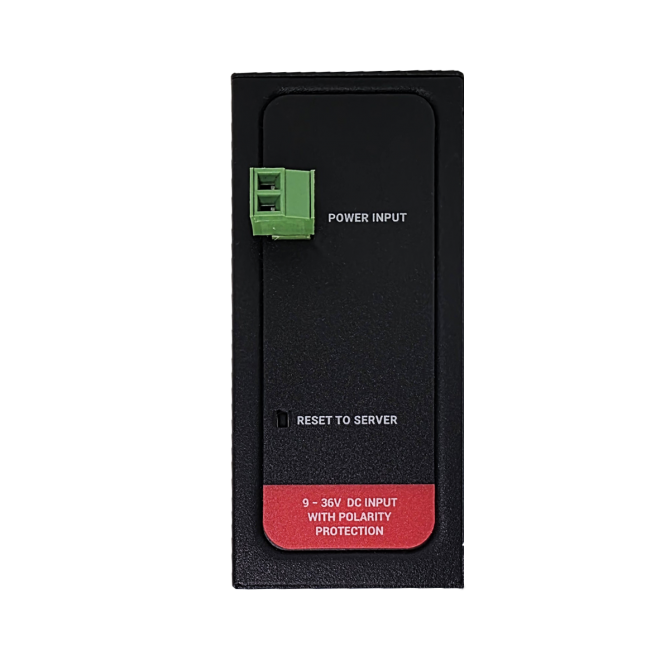
CKL Series Modbus, Serial to Ethernet Gateways have standard Ethernet ports. According to the link type, the switches use CAT 3, 4, 5, 5e UTP cables to connect to any other network device (PCs, servers, switches, routers, or hubs).
| Cable | Type | Max. Length | Connector |
| 10BASE-T | Cat. 3, 4, 5 100-ohm | UTP 100 m (328 ft) | RJ-45 |
| 100BASE-TX | Cat. 5 100-ohm UTP | UTP 100 m (328 ft) | RJ-45 |
With 100BASE-TX/10BASE-T cable, pins 1 - 2 are used for transmitting data and pins 3 - 6 are used for receiving data.
| Pin Number | Description |
| 1 | TD+ |
| 2 | TD- |
| 3 | RD+ |
| 4 | Not Used |
| 5 | Not Used |
| 6 | RD- |
| 7 | Not Used |
| 8 | Not Used |
| CAT5 Based System | BPL Link Based System | |
| Media | CAT5 | Power Line |
| Bandwidth | 100Mbps | Up to 30Mbps |
| Re-Wire | Yes | No, Using existing Power Line |
| Span | <100m | <600m |
| Multiple Nodes | N/A | Up to 10 hops/1000 nodes |
| Encryption | Yes, but difficult to configure | Yes, Plug & Play |
| Installment | Difficult | Easy, simply user power line |
| Installment Cost | High | Low |
| Total Cost | High | Low |

NOTE1 : BPL Model can be purchased in 2 versions:
1. P-N Model: Phase to neutral model (Standart Model). That version gets power from terminal pins 1 and 2 from phase and neutral. It can also transmit data from that pins and other pins usage is optional (Ex: Master can be connected to all phases and slaves can be connected to relevant phases)
2. P-P Model: Phase to phase model. That version also gets power from terminal pins 1 and 2 from phase and neutral. Data transmission only done through terminal pins 3 and 4. Phase to phase connection can be done to data transmission pins for better performance.
If phase to phase connection is not avilable then phase and neutral can still be connected for data transmission for terminal pins 3 and 4.

NOTE2: BPL Model can be purchased in DC model as well:
This model will be same as "P-P Model" (Phase to phase model) on data connection and gets 9-36V DC power from terminal pins 1 and 2 to power up device itself. Data transmission only done through terminal pins 3 and 4.
CKL Series Modbus, Serial to Ethernet Gateways have 1 x RS232 and 1 xRS485 port. Serial line can be connected other serial devices such as RTUs, PLCs, energy meters or any other field device.
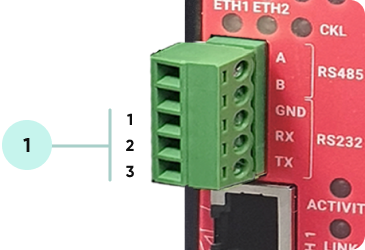
| Pin Number | Description |
| 1 | GND |
| 2 | Rx |
| 3 | Tx |
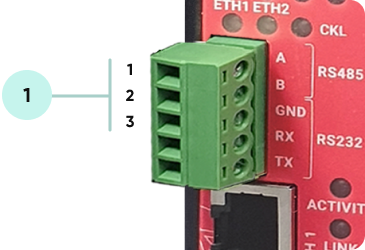
| Pin Number | Description |
| 1 | A |
| 2 | B |
| 3 | GND (Suggested to use) |

NOTE: Lite models have only 2 wire RS485 connection.
Some of the usage scenarios of CKL Series Serial to Ethernet Gateways are described below. Usages are not limited to that examples and user may create their own usage scenario.
CKL Series Serial to Ethernet Gateways can connect field serial device to TCP/IP Network to control that devices remotely with a software on a server or with a TCP/IP device. For example, with CKL Series Serial to Ethernet Gateways, users can connect field serial devices such as Electricity Energy Meters and create a system to read that devices remotely.

CKL Gateway devices in field configured for Transparent Communication and act as TCP Server to Serial Device Gateway. Field devices are connected over serial line either over RS232 or RS485 and communication data type and baud rate fixed.�
In need of remote reading of Electricity Energy Meters over optical probe, CKL can still be configured for Transparent Communication and act as TCP Server to Serial Device Gateway and a REDZ MBC144 can be connected for Auto Baud Rate Change together with REDZ KMK114 RS485 optical probe.
CKL Series Serial to Ethernet Gateways can connect field serial devices over TCP/IP Network just like they are connected over serial line. For example, with CKL Series Serial to Ethernet Gateways, users can connect 2 different field serial devices such as a Controller and a Sensor and create a system to communicate transparently over TCP/IP Network.
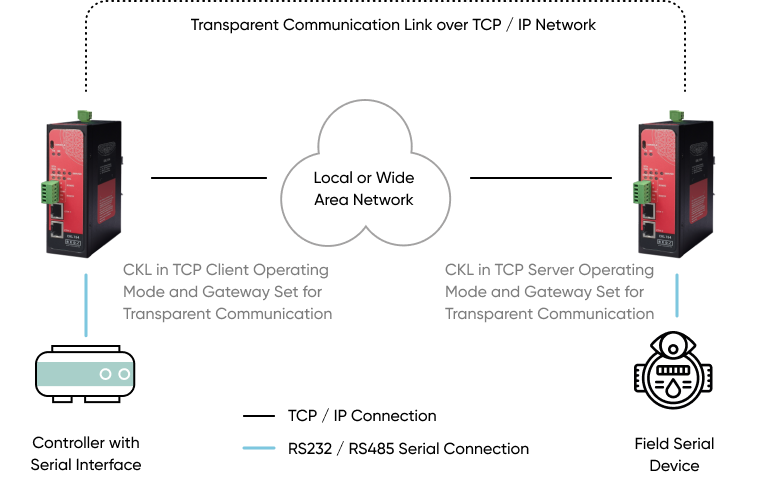
CKL Gateway device in Controller side configured for Transparent Communication and act as TCP Client to Serial Device Gateway. Field device is connected over serial line either over RS232 or RS485 and communication data type and baud rate fixed. CKL can connect to Other CKL device on sensor side by manual entering the IP and port of TCP Server side.
CKL Gateway device in sensor side configured for Transparent Communication and act as TCP Server to Serial Device Gateway. Field device is connected over serial line either over RS232 or RS485 and communication data type and baud rate fixed.�
�

NOTE:� TCP/IP link can also be created over Broadband Powerline - BPL. This way, 2 serial device can communicate over power lines without need of extra cable.
Example: This solution can be used to communicate between Solar Inverters and local energy meters.
�
CKL Series Serial to Ethernet Gateways can connect field Modbus RTU serial device to TCP/IP Network to control that devices remotely with a software on a server or with a TCP/IP device that communicates in Modbus TCP protocol. For example, with CKL Series Serial to Ethernet Gateways, users can connect field Modbus RTU serial devices such as remote sensors and remote Input/output modules to TCP/IP network and create an automation system.
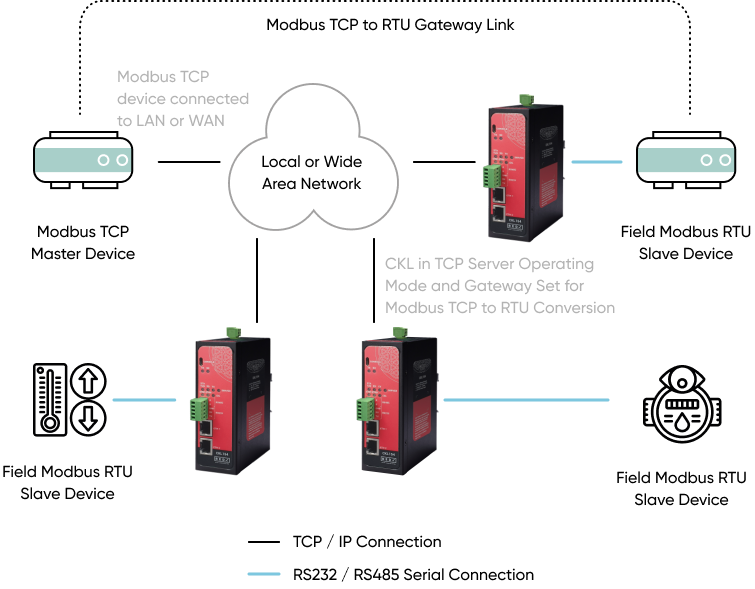
CKL Gateway devices in field configured for Modbus TCP to RTU Conversion and act as TCP Server to Serial Device Gateway. Field devices are connected over serial line either over RS232 or RS485 and communication data type and baud rate fixed.
CKL Series Serial to Ethernet Gateways can connect field Modbus RTU serial device to TCP/IP Network to control that devices remotely. If master side is Modbus RTU, CKL Series Serial to Ethernet Gateways can connect that part to TCP/IP network as well to make Modbus RTU to TCP conversion. For example, with CKL Series Serial to Ethernet Gateways, users can connect field Modbus RTU serial devices such as remote sensors and remote Input/output modules to Modbus RTU master device over TCP/IP network and create an automation system.
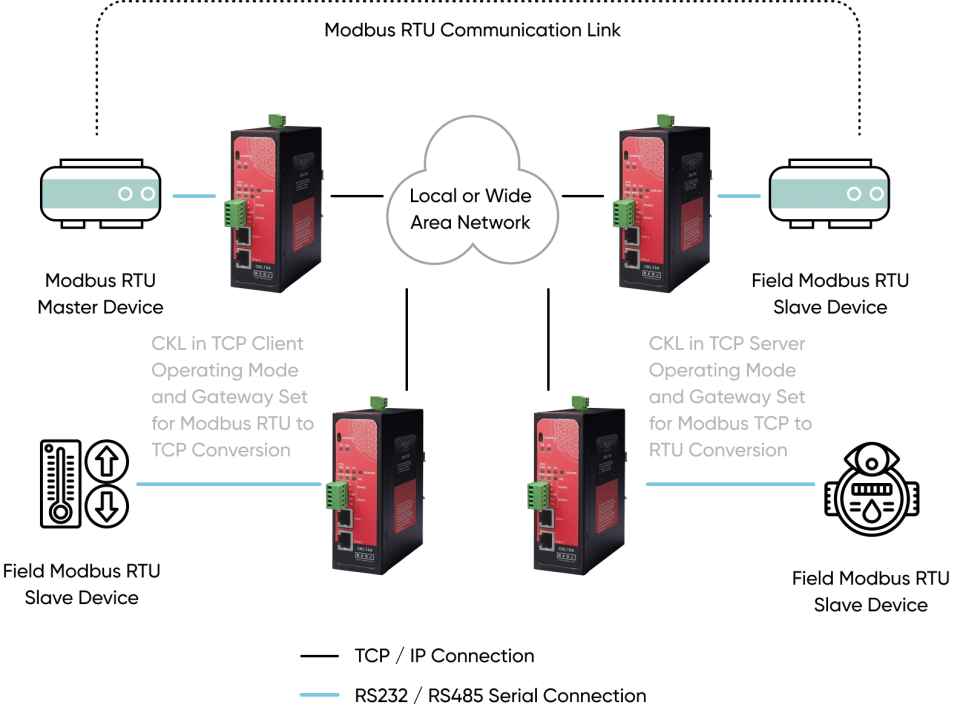
CKL Gateway device on Modbus RTU Master side configured for Modbus RTU to TCP Conversion and act as TCP Client to Serial Device Gateway. Field devices are defined as a list in configuration to enable mapping with field devices Modbus Addresses and related CKL remote fixed TCP IPs and ports.
CKL Gateway devices in field configured for Modbus TCP to RTU Conversion and act as TCP Server to Serial Device Gateway. Field devices are connected over serial line either over RS232 or RS485 and communication data type and baud rate fixed.�
CKL Series Serial to Ethernet Gateways can read field Modbus RTU devices such as sensors, Input/output modules, Energy Analyzers, LKM Series IEC Meter to Modbus RTU protocol gateways etc. and send their data to Modbus MQTT Server.
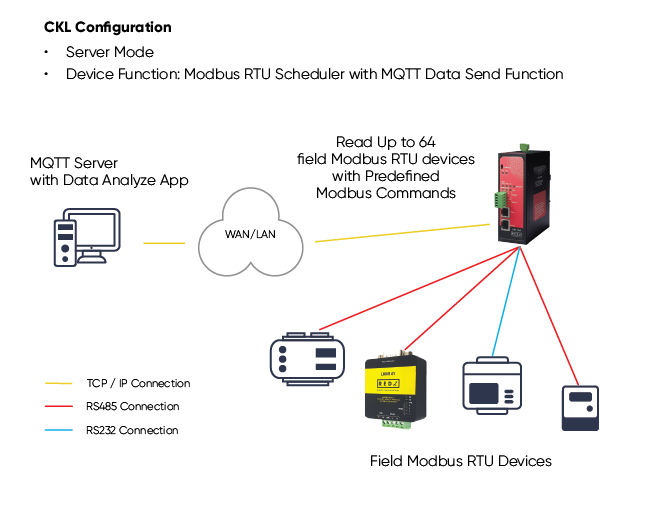
Field devices can be connected to RS232 and RS485 ports of CKL and up to 64 commands can be defined to read Modbus devices. CKL will check commands individually and read field device based on predefined Modbus command and as well as serial communication settings.

NOTE:� Lıte Models do not support this "Device Function"
�
CKL Series Serial to Ethernet Gateways can read field Modbus TCP devices such as Energy Analyzers, Controllers, Modbus TCP meters etc. and send their data to Modbus MQTT Server.
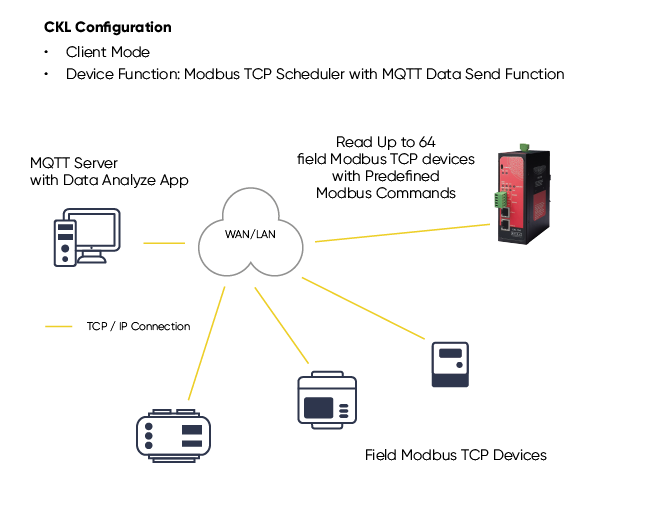
Field devices can be connected to TCP/IP ports of CKL or directly to LAN and up to 64 commands can be defined to read Modbus devices. CKL will check commands individually and read field device based on predefined Modbus command and as well as TCP/IP communication settings.

NOTE:� Lıte Models do not support this "Device Function"
�
CKL Series Serial to Ethernet Gateways can be configured over web interface.
Device will get IP from DHCP client when connected to a network. User can use discovery tool to see IP of the device.
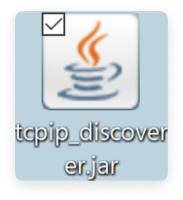
Once the IP of the device is set, user may login the device by simply typing the Ip address of device.
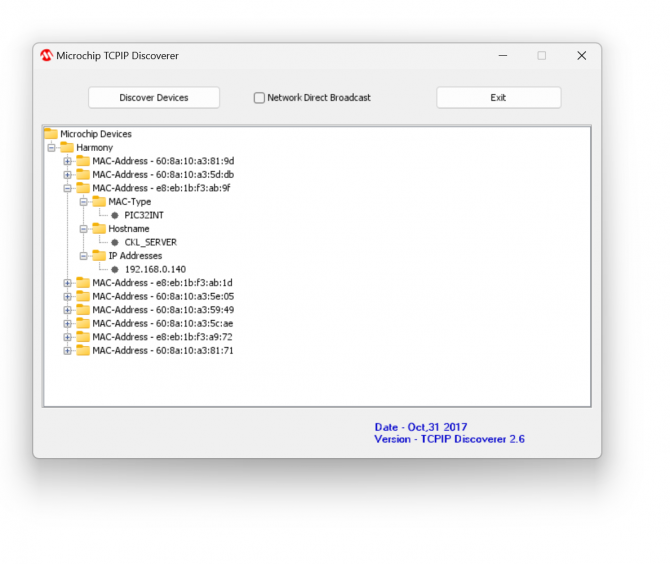

NOTE 1: CKL default firmware runs with DHCP off and expects an IP lease. If user needs static IP or prefers DHCP on during start up, it can easily be configured from the the web interface.

NOTE 2: If there is no DHCP server in LAN, REDZ device will get default 192.168.1.1 IP.
Simply write IP of the device to the http client. Login screen will pop up.
Default user name: admin
Default password: admin
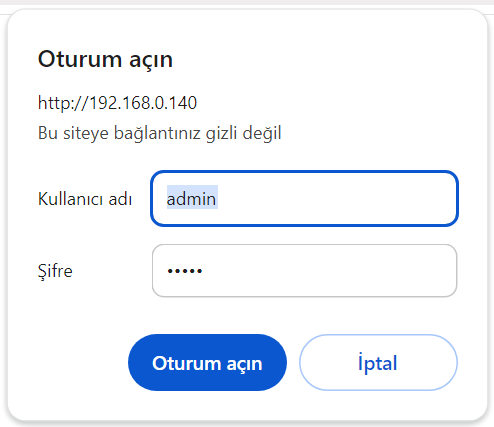
Main screen of device will appear with following information.
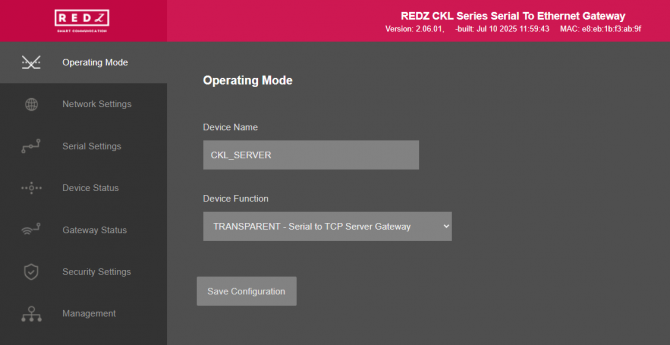
Firmware Info, MAC details and Device Name on top
Menu Items on left
Menu Item details in center
From this menu user may select the operating mode of the device and set the Device Function.
CKL Series Serial to Ethernet Gateway is one device with 6 different functions.

NOTE: Lite models do not support "Modbus TCP/RTU Scheduler with MQTT Data Send Function".
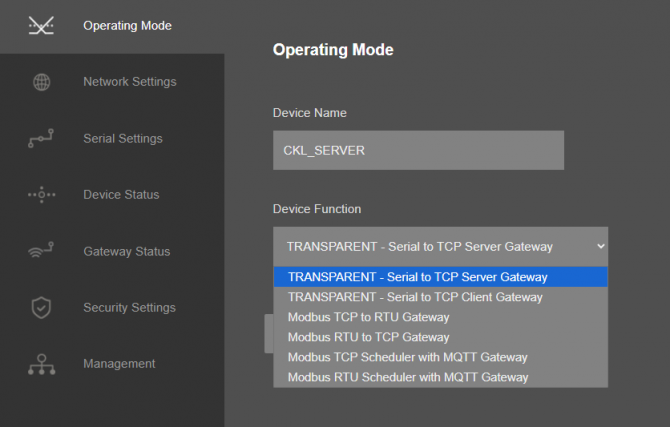
“Device Name” field is used to identify device.
“Device Function” field is used to select device behaviour as per options described above.
Available options are:
TRANSPARENT - Serial to TCP Server Gateway
TRANSPARENT - Serial to TCP Client Gateway
Modbus TCP to RTU Gateway
Modbus RTU to TCP Gateway
Modbus TCP Scheduler with MQTT Gateway
Modbus RTU Scheduler with MQTT Gateway
If "Device Function" is set to “TRANSPARENT - Serial to TCP Server Gateway”, following screen will be available to configure target TCP/IP devices.
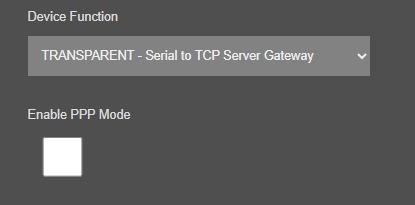
Up to 32 remote TCP/IP devices can connect to CKL and CKL will act Transparent gateway between TCP/IP devices and Serial devices. If "Enable PPP Mode" checked following screen will be available to configure:
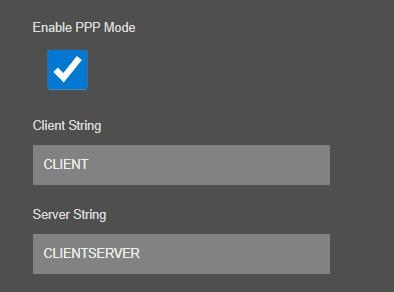
Client string is the string setting for serial devices. Whenever CKL gets that string message from serial side, it will automatically send Server string to serial side. Besides that it still acts as Transparent gateway between TCP/IP devices and Serial devices.

NOTE: CKL can accept up to 32 simultaneous TCP/IP connections and all devices can send CKL data over TCP/IP network. LITE models support up to 10 TCP/IP connection.
If "Device Function" is set to “TRANSPARENT - Serial to TCP Client Gateway”, following screen will be available to configure target TCP/IP devices.

"Target TCP IP": Static TCP IP address of the remote/local TCP Device that the CKL will connect.
"Target TCP Port": TCP IP port of the remote/local TCP Device that the CKL will connect.
"Enable": Enable remote device connection to let CKL connect the remote TCP/IP device automatically. At least 1 remote device must be enabled. Maximum 10 remote devices can be connected.
If "Device Function" is set as "Modbus RTU to TCP Gateway", following settings will be shown.
CKL will expect a connection from a Modbus RTU Master device and get Modbus RTU commands over the Serial line (RS232 or RS485). Based on Modbus Addresses of received commands, CKL routes the data to target Modbus TCP device. CKL also converts received Modbus TCP response and with the same idea sends it to Serial line.
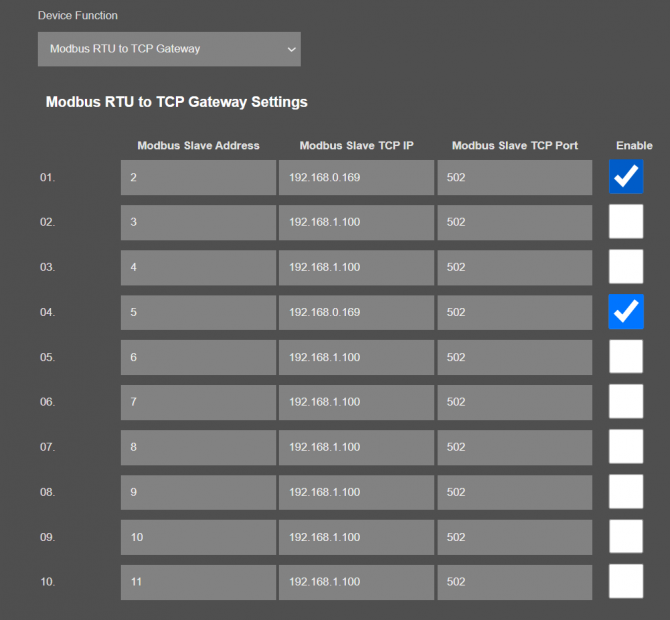
"Modbus Slave Address": Remote Modbus TCP Device Address
"Modbus Slave TCP IP": Remote Modbus TCP Device static TCP IP
"Modbus Slave TCP Port": Remote Modbus TCP Device TCP/IP port
"Enable": Enable remote device connection to let CKL connect the remote Modbus TCP device automatically. At least 1 remote device must be enabled. Maxmimum 10 remote devices can be connected.
If "Device Function" is set as "Modbus TCP Scheduler with MQTT Gateway", following settings will be shown.
Users may enter Modbus TCP Scheduler details including TCP/IP parameters and Modbus TCP command settings and query intervals.


NOTE: Up to 64 commands can be defined. User can read many registers with 1 command.
CKL has smart mechanism to manage TCP sockets and CKL will use up to 32 sockets to connect remote/local Modbus TCP devices. If all commands send to 1 TCP IP and port then 1 socket will be used, if there are more than 32 TCP/IP address in list, then CKL will use next free socket to connect the next device.
If "Device Function" is set as "Modbus RTU Scheduler with MQTT Gateway", following settings will be shown.
Users may enter Modbus RTU Scheduler details including Serial interface settings and Modbus RTU command settings and query intervals.


NOTE: Up to 64 commands can be defined. User can read many registers with 1 command.
Once the setting has been changed, “Save Configuration” button will be enabled.

After clicking button system will tell if the settings applied successfully or not.


NOTE: Settings will be applied once the device is rebooted from web interface or repowered manually.
From this menu user may change the network settings of the device based on selected "Device Function".
In all selected "Device Function" modes, user can edit following options:

NOTE:
NTP is used to syncronize device time. Device checks if NTP time server is available in every 10 seconds after repower. Device synhcronizes its time if NTP time is available and stops checking after successfull synchronization.
Also "Device Function" additional options are given below.
Serial to TCP Server Transparent Gateway Function:
Modbus TCP/RTU Protocol Gateway Function:
Modbus TCP/RTU Scheduler with MQTT Data Send Function:

"Server Listening Port": TCP Port that CKL uses for incoming connections. Remote devices can use CKL IP and this port to connect to CKL for TCP/IP communication.
"Maximum Number of Clients": Maximum numbers of incoming connections accepted. CKL can accept up to 32 simultaneous connection and all devices can send CKL data over TCP/IP network.

NOTE: CKL can accept up to 32 simultaneous TCP/IP connections. LITE models support up to 10 TCP/IP connection.
"Use Static Address for Device": Set a static TCP IP for CKL from this part. Enable and enter network settings and CKL will be available to connect from this static IP locally or remotely (gateway must be set properly for remote WAN connection).
Following parameters are available for "Device Function: Modbus TCP or Modbus RTU Scheduler with MQTT Data Send Function" :
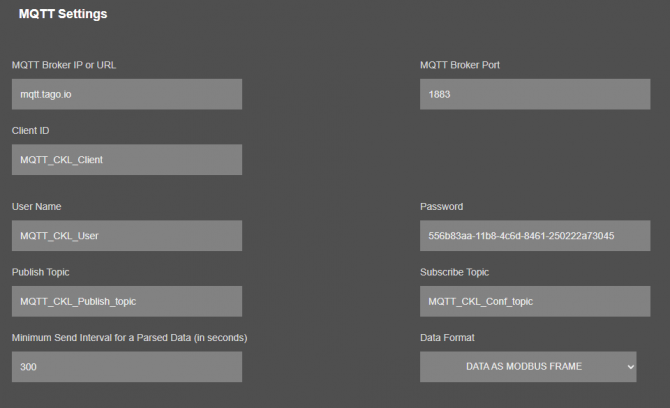
"NTP Server": NTP Server address that used in MQTT data transmission.
"MQTT Broker IP": TCP IP of the MQTT Server. User must enter IP value
Ex: 75.2.83.130 is for "https://tago.io/" web address
"MQTT Broker Port": TCP Port of the MQTT Server.
Ex: 1883 is for "https://tago.io/" web address
"Client ID": MQTT Publisher client ID. Default is MQTT_CKL_Client.
Maximum length for this field is 32.
"User Name": MQTT Publisher user name. This must be entered based on MQTT server settings.
Maximum length for this field is 64.
"Password": MQTT Publisher password. This must be entered based on MQTT server settings.
Maximum length for this field is 48.
"Publish Topic": MQTT Publisher topic value. Default is MQTT_CKL_Publish_topic.
Maximum length for this field is 32.
"Subscribe Topic": MQTT Publisher subscribe topic value. Default is MQTT_CKL_Subscribe_topic.
Maximum length for this field is 32.
"Minimum Send Interval for a Parsed Data (in seconds)": Minimum value to send meter data to MQTT Server. This time may be longer due to meter quantity in reading queue.
"Data Format": Options for how data is shared by CKL with MQTT server. There are 2 options:
DATA AS MODBUS FRAME
When selected as "DATA AS MODBUS FRAME", CKL will share data as follows
Device Name, NTP Time, Modbus Command/Device Number Configured in CKL Scheduler List and Data itself in hexadecimal format just like a Modbus query response.
First byte will show Modbus Device Address
Second byte is Modbsu Function Code
Third byte shows data bytes count and rest is the data itself
Here is an example:
1st Byte: 05 is the Modbus Device Address
2nd Byte: 03 is the Function Code, Read Holding Registers
3th Byte: 0E is 14 in decimal. That means there are 7 registers and each has 2 bytes
1st register: 6DF1 which is 28145 decimal
Next registervalues can be found seen in same manner.

NOTE: Lite models do not support "Modbus TCP/RTU Scheduler with MQTT Data Send Function", thus has no settings interface for MQTT connectivity.
Following parameters available if “DHCP Server” setting is enabled. This is used if DHCP server is needed in network. CKL can distribute IP to field devices connected to it in this way.

Also if the device has Broadband Power Line (BPL) option:
User can select operating mode of BPL either MASTER or NODE.

NOTE: Standard firmware of REDZ BPL supports up to 10 hops and 1000 nodes. Only 1 device can be MASTER in same network.

Once the setting has been changed, “Save Configuration” button will be enabled.

After clicking button system will tell if the settings applied successfully or not.
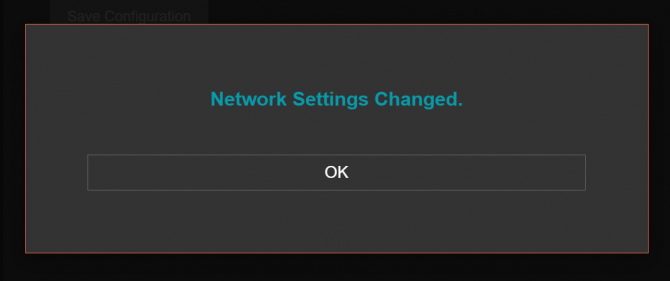

NOTE : Settings will be applied once the device is rebooted from web interface or repowered manually.
This menu will only be available on following "Device Function"s.
Serial to Ethernet Transparent Gateway Function
Modbus RTU/TCP Protocol Gateway Function
and will not be available for "Modbus RTU/TCP Scheduler with MQTT Data Send" Functions
From this menu user may change settings related with RS232 or RS485 connection. Only one of the communication will be available at a time (RS232 or RS485).

NOTE: Lite models only support RS485 serial connection.

"Baud rate": Serial communication baud rate selection.
"Line Control": Serial communication data type selection in form of Data bits-Parity-Stop bits. Available options are:
7_EVEN_1 (Not used in Modbus)
8_NONE_1
9_NONE_1
8_EVEN_1
8_EVEN_2
8_ODD_1
8_ODD_2
8_NONE_2
9_NONE_2
Once the setting has been changed, “Save Configuration” button will be enabled.

After clicking button system will tell if the settings applied successfully or not.
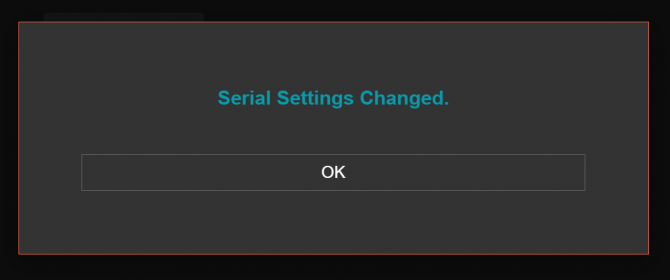

NOTE: Settings will be applied once the device is rebooted from web interface or repowered manually.
From this menu user may monitor device status and statistics based on operating mode of device. The page also helps users to check device health.
Shown parameters changes bsed on selected "Device Function" and following parameters are available for "Device Function":
TRANSPARENT - Serial to TCP Server Gateway:
TRANSPARENT - Serial to TCP Client Gateway:
Modbus TCP to RTU Gateway:
Modbus RTU to TCP Gateway:
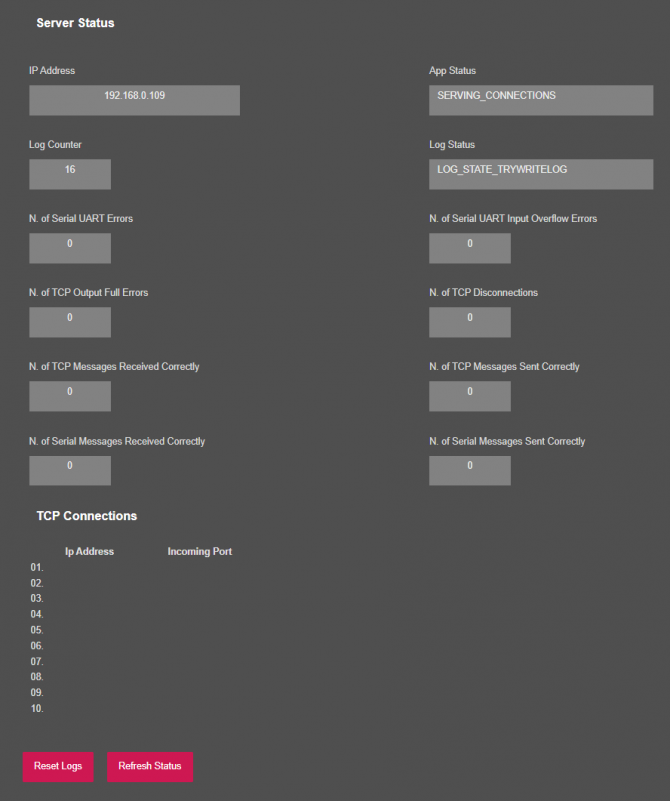
"IP Address": TCP/IP address of CKL itself.
"App Status": It shows current status of CKL application. "SERVING CONNECTIONS" means device is ready for normal operation.
"Log Counter": It is only available when "Log" is enabled from "Management" menu and shows how many log lines has been transfered till now.
"Log Status": It is only available when "Log" is enabled from "Management" menu and shows current status of CKL logging. "LOG_STATE_TRYWRITELOG" means normal operation.
"N. of Serial UART Errors": Number of module uart errors. Device will enter "Reboot State" if this number is above 20.
"N. of Serial UART Input Overflow Errors": Number of module input overflow errors.
"N. of TCP Output Full Errors": Number of TCP output full errors expected to be 0 in normal operation.
"N. of TCP Disconnections": Number of TCP disconnections from CKL.
"N. of TCP Messages Received Correctly": Number of packages received from TCP/IP Side.
"N. of Serial Messages Sent Correctly": Number of packages sent to serial line RS232 or RS485.
Following additional parameters are available for "Device Function"
Modbus TCP to RTU Gateway:
Modbus RTU to TCP Gateway:

"N. of CRC Errors on Modbus Input Messages": Number of CRC erros on received Modbus RTU Protocol Data Unit.
"N. of Incorrect Serial Characters Received": Number of incorrect packages length received from Serial Line that does not fit Protocol Data Unit that device uses.
"N. of Incorrect TCP Characters Received": Number of incorrect packages length received from TCP/IP Side that does not fit Protocol Data Unit that device uses.
In "TCP Connections" part for "TRANSPARENT - Serial to TCP Server Gateway" and "Modbus TCP to RTU Gateway" Device Functions:
Device can show up to 32 lines in this part based on "Maximum Number of Clients" setting under "Network Settings" Menu.
"Ip Address": Is the TCP IP address of client connected to CKL.
"Incoming Port": Is the TCP Port of socket used by client connected to CKL.

NOTE: CKL can accept up to 32 simultaneous TCP/IP connections and all devices can send CKL data over TCP/IP network. LITE models support up to 10 TCP/IP connection.
In "TCP Client Status" part for “TRANSPARENT - Serial to TCP Client Gateway” and "Modbus RTU to TCP Gateway" Device Functions:
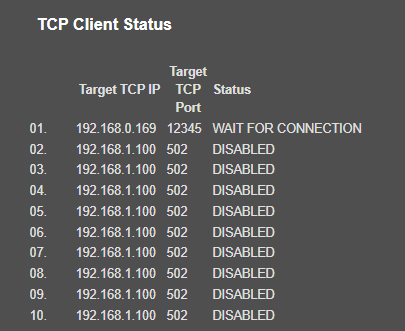
"Target TCP IP": Shows the configured static TCP IP for the remote/local TCP/IP device
"Target TCP Port": Shows the configured TCP port for the remote/local TCP/IP device
"Status": Shows connection status of remote/local device. Following status values are available:
"CONNECTED": connected to remote/local TCP/IP device.
"WAIT FOR CONNECTION": Device is reachable and CKL is trying to open TCP/IP connection.
"OPENING CONNECTION": CKL will check TCP/IP connection if the remote/local TCP/IP device is reachable.
"HOST UNREACHABLE": Remote/local TCP/IP device is not reachable ( ex: not in LAN/WAN network)
"DISABLED": This connection is not enable and CKL will not check.
Following parameters are available for "Device Function":
Modbus TCP Scheduler with MQTT Data Send Function:
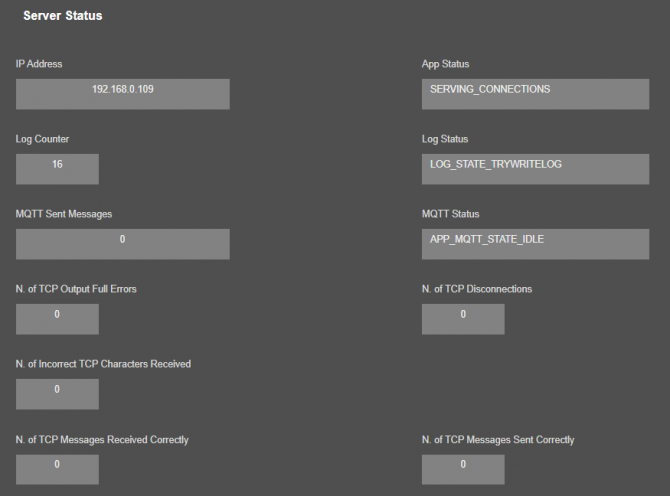
"IP Address": TCP/IP address of CKL itself.
"App Status": It shows current status of CKL application. "SERVING CONNECTIONS" means device is ready for normal operation.
"Log Counter": It is only available when "Log" is enabled from "Management" menu and shows how many log lines has been transfered till now.
"Log Status": It is only available when "Log" is enabled from "Management" menu and shows current status of CKL logging. "LOG_STATE_TRYWRITELOG" means normal operation.
"MQTT Sent Messages": It shows how many MQTT messages has been transfered till now.
"MQTT Status": It shows current status of CKL MQTT Publisher. "APP_MQTT_STATE_SUBSCRIBED" means MQTT publisher is ready for normal operation.
"N. of TCP Output Full Errors": Number of TCP output full errors expected to be 0 in normal operation.
"N. of TCP Disconnections": Number of TCP disconnections from CKL.
"N. of Incorrect TCP Characters Received": Number of incorrect packages length received from TCP/IP Side that does not fit Protocol Data Unit that device uses. It sholud be 0 in Transparent Operating Mode.
"N. of TCP Messages Received Correctly": Number of packages received from TCP/IP Side.
In "Modbus TCP Master Status" part:
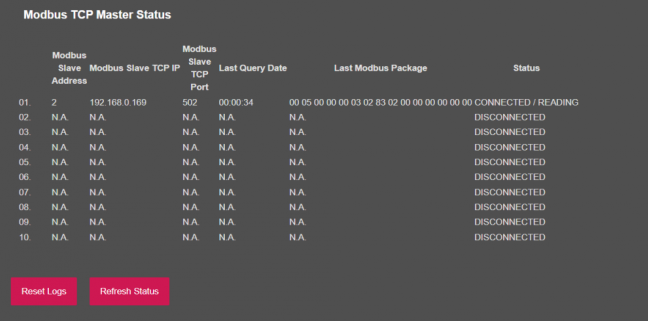
Device will show 10 lines in this part for connecting up to 64 devices described in command list.
"Modbus Slave Address": Is the Modbus Slave address for defined command that is executed.
"Modbus Slave TCP IP": Shows the configured static TCP IP of the remote Modbus device for command that is executed.
"Modbus Slave TCP Port": Shows the configured TCP Port of the remote Modbus device for command that is executed.
"Last Query Date": Is the last time the command executed.
"Last Modbus Package": Is the last modbus frame received for the command executed.
"Status": Is the status for command execution.

NOTE: Lite models do not support "Modbus TCP/RTU Scheduler with MQTT Data Send Function", thus they have no status interface for it.
Following parameters are available for "Device Function":
Modbus RTU Scheduler with MQTT Data Send Function:

"IP Address": TCP/IP address of CKL itself.
"App Status": It shows current status of CKL application. "SERVING CONNECTIONS" means device is ready for normal operation.
"Log Counter": It is only available when "Log" is enabled from "Management" menu and shows how many log lines has been transfered till now.
"Log Status": It is only available when "Log" is enabled from "Management" menu and shows current status of CKL logging. "LOG_STATE_TRYWRITELOG" means normal operation.
"MQTT Sent Messages": It shows how many MQTT messages has been transfered till now.
"MQTT Status": It shows current status of CKL MQTT Publisher. "APP_MQTT_STATE_SUBSCRIBED" means MQTT publisher is ready for normal operation.
"N. of Serial UART Errors": Number of module uart errors. Device will enter "Reboot State" if this number is above 20.
"N. of Serial UART Input Overflow Errors": Number of module input overflow errors.
"N. of CRC Errors on Modbus Input Messages": Number of CRC errors during getting Modbus packages.
"N. of Incorrect Serial Characters Received": Number of incorrect packages length received from Serial Line that does not fit Protocol Data Unit that device uses.
"N. of Serial Messages Sent Correctly": Number of packages sent to serial line RS232 or RS485.
In "Modbus RTU Master Status" part:

Device will show 10 lines in this part for connecting up to 64 devices described in command list.
"Modbus Slave Address": Is the Modbus Slave address for defined command that is executed.
"Modbus Slave Serial Port": Is the port defined for command that is executed.
"Modbus Slave Data Type": Is the serial data baud rate and data type defined for command that is executed.
"Last Query Date": Is the last time the command executed.
"Last Modbus Package": Is the last modbus frame received for the command executed.
"Status": Is the status for command execution.

NOTE: Lite models do not support "Modbus TCP/RTU Scheduler with MQTT Data Send Function", thus they have no status interface for it.
After clicking “Refresh Status” button, system will reload data only and will not reload page. Button will be disabled during reload for an instance. If timeout occurs during the reload, the button will be enabled again with warning of timeout. In normal operation reload of status data will be done immediately.
From this menu user may monitor received and sent package details. The latest messages received from TCP/IP and RS232/RS485 serial sides shown here both in HEX and ASCII (if representable) formats with time stamps.

Latest Message Received - TCP Side
"Message Time": Time when last package received from TCP/IP side.
"Length": Package length of last message received from TCP/IP side.
"Payload in Hex": Data received visualization in HEXADECIMAL format of last package received from TCP/IP side.
"Payload in ASCII": Data received visualization in ASCII format of last package received from TCP/IP side. Only available for Device Functions "TRANSPARENT - Serial to TCP Server Gateway" and "TRANSPARENT - Serial to TCP Client Gateway".
Latest Message Received - Serial Side
"Message Time": Time when last package received from Serial (RS232 or RS485) side.
"Length": Package length of last message received from Serial (RS232 or RS485) side.
"Payload in Hex": Data received visualization in HEXADECIMAL format of last package received from Serial (RS232 or RS485) side.
"Payload in ASCII": Data received visualization in ASCII format of last package received fromSerial (RS232 or RS485) side. Only available for Device Functions "TRANSPARENT - Serial to TCP Server Gateway" and "TRANSPARENT - Serial to TCP Client Gateway".
After clicking “Refresh Gateway Status” button, system will reload data only and will not reload page. Button will be disabled during reload for an instance. If timeout occurs during the reload, the button will be enabled again with warning of timeout. In normal operation reload of status data will be done immediately.
This menu is to enable filtering TCP/IP connections based on IP of the devices.
This menu is available only in following "Device Function"s:
TRANSPARENT - Serial to TCP Server Gateway:
Modbus TCP to RTU Gateway:
From this menu user may activate TCP IP filter based on White list (accepted packages from IP Address) or Black list ( rejected packages from IP Address).

Up to 20 IPs to be filtered are available for any of the list.
Following settings are available for any of the list:

In this page user can enter 0.0.0.0 or the exact IP value of the device. The options with 0.0.0.0 will be discarded (not filtered).
Once the setting has been changed, “Save Configuration” button will be enabled.

After clicking button system will tell if the settings applied successfully or not.


NOTE : Settings will be applied once the device is rebooted from web interface or repowered manually.
From this menu user may change parameters or send command to device.
The device restarts itself every 86400 seconds (which means every 24 hours). There are also timeout restart routines in Server mode during listening clients and in Client Mode trying to connect to the server. ( both preset to 10 minutes which means device will restart system if fails to connect a server in Client mode or a client do not connect in preset time in Server mode.)

NOTE: NTP is used to syncronize device time. Device checks if NTP time server is available in every 10 seconds after repower. Device synhcronizes its time if NTP time is available and stops checking after successfull synchronization.
After a firmware change old configuration will be used for minor changes. If a major change occurs system will restore to factory default configuration.
User can change the login information
User can change the debug level of the device. REDZ CKL Series Serial to Ethernet Gateways series have micro USB and gives log in 115200 - 8N1 format.
Any terminal program can be used to listen the LOG over USB type-C or micro USB port of the device which is recognized as Virtual COM port in PC.
LOG to remote UDP server is also available. If set to UDP server, then CKL will send LOG data to remote UDP server device.

NOTE: Lite models do not have Console port for LOG. They still supports LOG to remote UDP.
User can restore to factory settings and force device to reboot. Factory settings restored by clicking "Restore Factory Configuration" button.
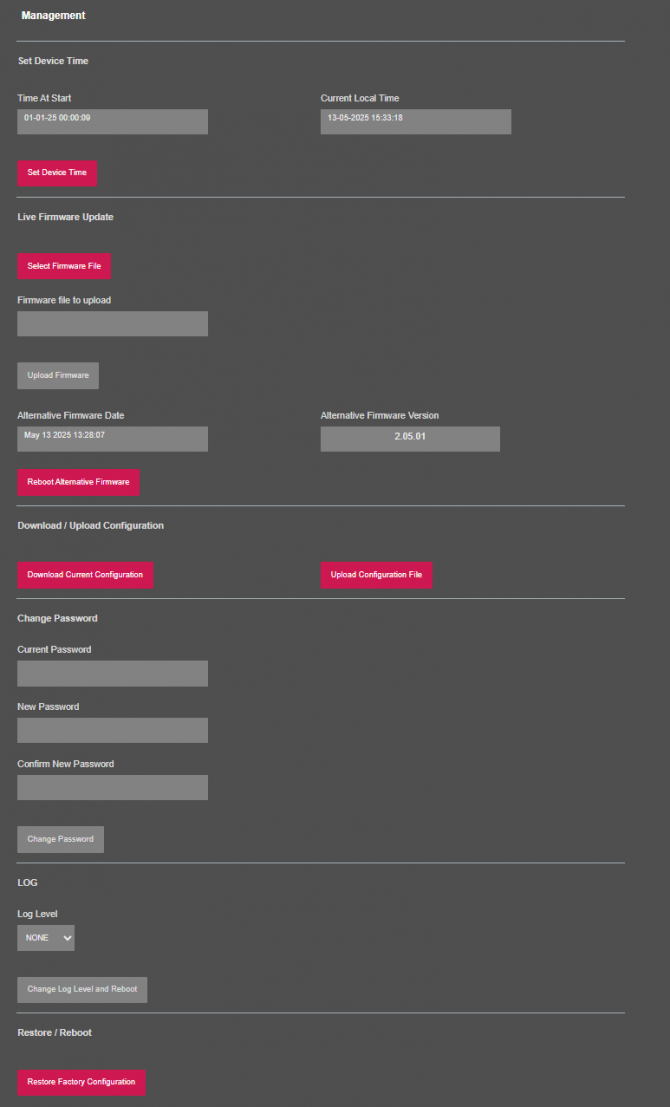
In "Live Firmware Update" part:
Firmware upgrade is possible only with files that REDZ supplied. Once the file selected, CKL shows selected file:

Then “Upload Firmware” button must be clicked. CKL will start to upload file and show status on pop up screen.

Click "Close" when finished. If somehow CKL fails to upload, refresh webpage and try again please.
After successful upload, CKL will show "Alternative Firmware Date" and "Alternative Firmware Version" data.

Click "Reboot Alternative Firmware" and CKL will reboot with new firmware and show status on screen.
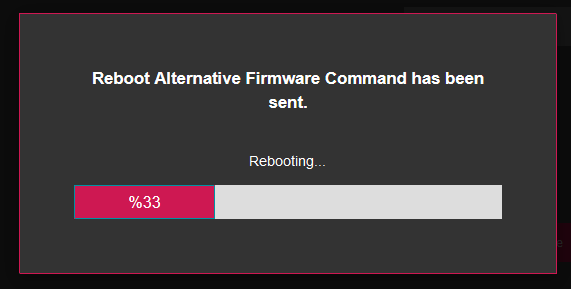
Check firmware details from upper part of main screen please if the update firmware procedure finalized properly.

NOTE 1: User must refresh cache of their browser by clicking CTRL+F5 after a succesfull firmware change so that it will force browser to reload web interface (with latest updates/changes).

NOTE 2: In major updates user must also reset device to factory settings.
In "Download / Upload Configuration" part:
User download current configuration of the device to a file or restore a previously defined configuration to device from file.
"Download Current Configuration": Downloads the configuration to a file. It uses "Device Name" for file name and the extensions will be "*.zcfg".
"Download Configuration File": Uploads the configuration from "*.zcfg" file.
In "Log" part:
User may activate Logging and see details of operation. There are different levels of Log with different amount of data.
"None": Logging is closed
"Error": Only errors in systems will be logged
"Info": General info and errors will be logged
"Debug": All details regarding device operation will be logged
If "Console" is selected as output of Log, then micro USB or USB Type-C port of device will be used for logging. Proper cable must be connected and a teminal should be used to receive Log data. As an example "RealTerm" tool can be used.
Simply select COM port and set baud rate 115200 and data type 8N1 and then click open. Device will send log data.


NOTE: Lite models do not have Console port for LOG. They still supports LOG to remote UDP.
If "UDP Server" is selected as output of Log, then proper tool must be used to get log data. User must set "UDP Server IP" and "UDP Server Port". Device will send Log to that address. As an example "Package Sender" tool can be used.
Click "File" and then "Settings". Enable "UDP Server" and set the port. Device will send Log data to UDP server.
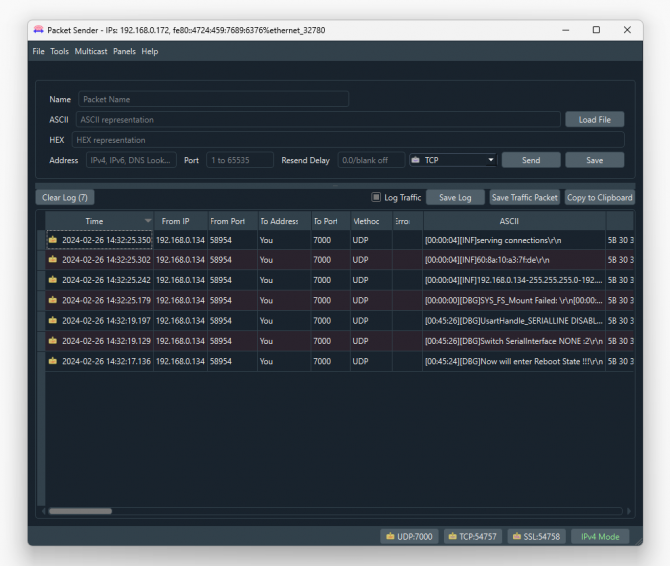
Here is a video example to enable UDP log and receive data via UDP Server software:
CKL Series Serial to Ethernet Gateways can connect all field serial devices to TCP/IP based network. It is one device with 3 different functions and 6 different working modes.
Serial to Ethernet Transparent Gateway Function: It can work in TCP Server mode so that TCP client devices can connect to CKL and CKL will act as transparent gateway between TCP devices and field serial devices.
It can work in TCP client mode and CKL can automatically connect remote TCP devices and act as transparent gateway between field serial devices and remote TCP devices.
Modbus TCP/RTU Protocol Gateway Function: Modbus TCP master devices can connect to CKL and CKL will act as converter between Modbus TCP master devices and field Modbus RTU serial devices.
Also Modbus RTU master devices can connect to CKL and CKL will act as converter between Modbus RTU master devices and field Modbus TCP devices by connecting them via Modbus Address to Target TCP IP List.
Modbus TCP/RTU Scheduler with MQTT Data Send Function: CKL can read field Modbus TCP or Modbus RTU devices based on predefined Modbus list and send read Modbus data to MQTT server based on predefined period. Up to 64 Modbus commands can be defined.

NOTE: Lite models do not support "Modbus TCP/RTU Scheduler with MQTT Data Send Function".
In this application we will show Modbus TCP to RTU Conversion. The devices will be:
We will use Modbus simulator as Modbus RTU device and "Modbus Poll" software as Modbus TCP master device in this application
CKL will listen TCP IP connections from the TCP Port set in "Network Settings" Menu. So we will set "Device Function" as "Modbus TCP to RTU Gateway" since we need to change Modbus TCP protocol and we want it to be transfered over serial line as Modbus RTU frame.

The listening TCP port will be "502" as per settings in "Network Settings" Menu.

User may increase "Maximum Number of Clients" if there is more than 1 master in the application.
Serial port will be RS485 and we will use 9600 baud with 8N1 data type in this application to communication with Modbus RTU slave device.

Those settings will be enough for CKL Modbus TCP to RTU conversion.

NOTE: Lite models only support RS485 serial connection.
CKL Series Modbus, Serial to Ethernet Gateway is now ready for communication between
Modbus RTU slave device address is 5 and we will read 5 register starting from register address 7.
Enter IP and port of Master CKL to Modbus TCP software and set "response timeout" and "delay between polls" according to TCP/IP network needs. Default values are usually ok for normal TCP/IP networks.
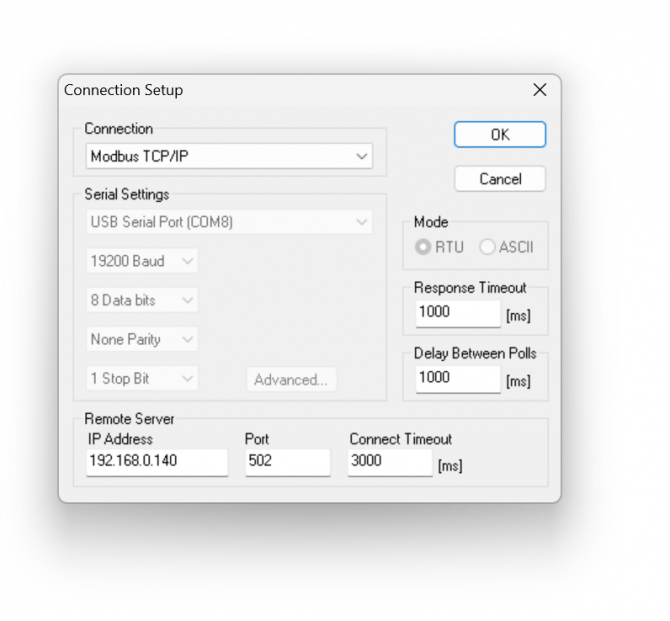
Click "OK" once finished. Software may try to connect, meanwhile please update settings as per your Modbus RTU slave device. In our example Modbus RTU slave device address is 5 and we will read 5 register starting from register address 10.
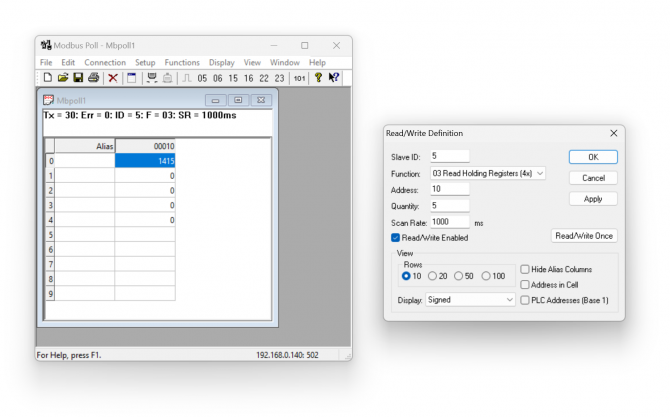
Now the software will read Modbus values. In "Device Status" page, number of received and sent packages from TCP/IP and serial interfaces, connected device details and other values can be monitored.
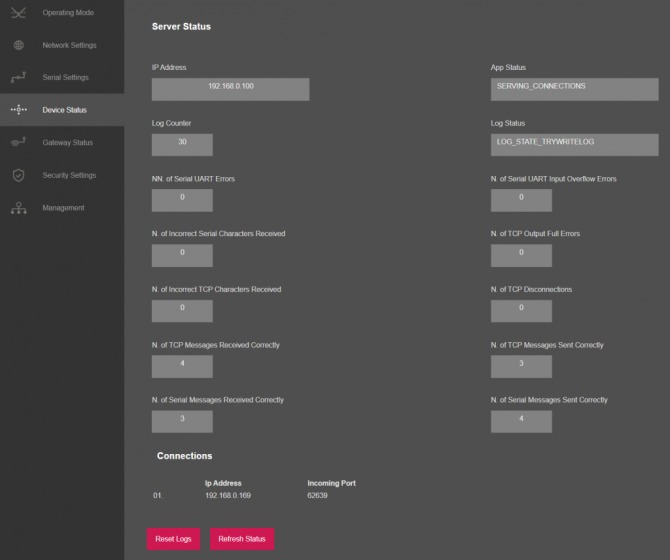
In "Gateway Status" page, details regarding Modbus TCP packages from TCP/IP interface and Modbus RTU packages from serial interface can be monitored.

CKL Series Serial to Ethernet Gateways can connect field Modbus RTU serial device to TCP/IP Network to control that devices remotely with a software on a server or with a TCP/IP device that communicates in Modbus TCP protocol. For example, with CKL Series Serial to Ethernet Gateways, users can connect field Modbus RTU serial devices such as remote sensors and remote Input/output modules to TCP/IP network and create an automation system.

CKL Gateway devices in field configured for Modbus TCP to RTU Conversion and act as TCP Server to Serial Device Gateway. Field devices are connected over serial line either over RS232 or RS485 and communication data type and baud rate fixed.
Here is an example video for BPL version of CKL series that is connected to LKM Series Modbus to IEC62056-21 Standard Protocol Gateway.
Here is the physicall application of same example.
CKL Series Serial to Ethernet Gateways can connect field serial device to TCP/IP Network transparently to control that devices remotely with a software on a server or with a TCP/IP device. For example, with CKL Series Serial to Ethernet Gateways, users can connect field serial devices such as Electricity Energy Meters and create a system to read that devices remotely.

CKL Gateway devices in field configured for Transparent Communication and act as TCP Server to Serial Device Gateway. Field devices are connected over serial line either over RS232 or RS485 and communication data type and baud rate fixed.
In need of remote reading of Electricity Energy Meters over optical probe, CKL can still be configured for Transparent Communication and act as TCP Server to Serial Device Gateway and a REDZ MBC144 can be connected for Auto Baud Rate Change together with REDZ KMK114 RS485 optical probe.
Here is an example video for CKL series that is connected to IEC62056-21 Standard Protocol Energy Meters over RS485.
Here is the physicall application of same example.
CKL Series Serial to Ethernet Gateways can read field Modbus RTU devices such as sensors, Input/output modules, Energy Analyzers, LKM Series IEC Meter to Modbus RTU protocol gateways etc. and send their data to Modbus MQTT Server.
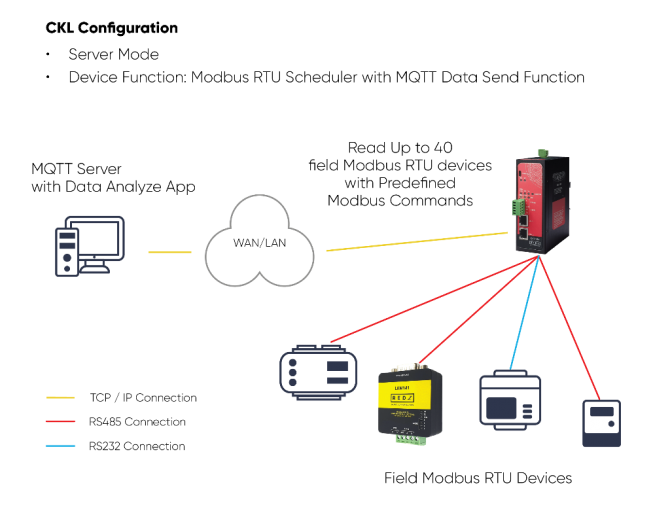
Field devices can be connected to RS232 and RS485 ports of CKL and up to 64 commands can be defined to read Modbus devices. CKL will check commands individually and read field device based on predefined Modbus command and as well as serial communication settings.
Here is an example video for CKL series that is connected to LKM144: MODBUS RTU to IEC62056-21 Protocol Meter Gateway over RS485.

NOTE: Lite models do not support "Modbus TCP/RTU Scheduler with MQTT Data Send Function".
Here is video for physical connections for same application.
CKL154: Serial to Ethernet Gateway, 2x 10/100 T(x) ETH ports, 1 x RS232 & 1 x RS485, 5-48V (max. 60V) DC Power Input
CKL254: Serial to Ethernet Gateway, 2x 10/100 T(x) ETH ports, 1 x RS232 & 1 x RS485, 100 - 240V AC (120 – 370V DC), 50Hz to 60Hz AC Power Input
CKL655: Serial to Ethernet Gateway, 2x 10/100 T(x) ETH ports + 1 x BPL (Broadband Power Line) Link, 1 x RS232 & 1 x RS485, 3 Phase AC Power Input, 110V–240V/50-60Hz
CKL154 - Lite: Serial to Ethernet Gateway, 1x 10/100 T(x) ETH port and 1 x RS485, 9-36V (max. 40V) DC Power Input
| Model | 9-36V (max. 40V) DC Power Input | 5-48V (max. 60V) DC Power Input | 100 - 240V AC (120 – 370V DC), 50Hz to 60Hz AC Power Input | 3 Phase AC Power input, 110V–240V/50-60Hz AC Power Input | Transparent Gateway Function Between Serial and Ethernet | Modbus TCP (Master) to RTU and Modbus RTU (Master) to TCP Gateway Function | Read Modbus RTU or TCP Devices and send to MQTT Server | BPL (Broadband Power Line) Link |
| CKL154 | X | X | X | X | ||||
| CKL254 | X | X | X | X | ||||
| CKL655 | X | X | X | X | X | |||
| CKL154 - Lite | X | X | X |
THIS SITE USES COOKIES
Various types of cookies are used on our website (and on all other digital platforms including mobile applications).
View our new THE INFORMATIVE TEXT ON LPPD AND PRIVACY here.
Google Analytics
Analytical cookies help us to improve our website by collecting and reporting information on its usage.
Google AdWords and Remarketing
We use marketing cookies to help us improve the relevancy of advertising campaigns you receive.
I have read the above articles